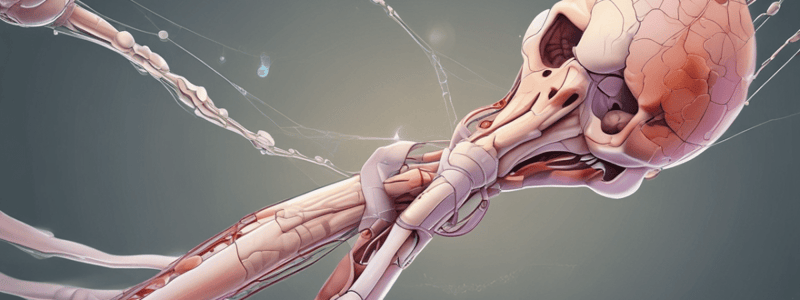Podcast
Questions and Answers
What is the consequence of a translocation on the gene preceding the breakpoint?
What is the consequence of a translocation on the gene preceding the breakpoint?
- The gene becomes a fusion protein
- The gene loses a part of its own protein (correct)
- The gene is deleted entirely
- The gene gains a part of another protein
Which of the following techniques is NOT suitable for detecting translocations in decalcified tissue?
Which of the following techniques is NOT suitable for detecting translocations in decalcified tissue?
- FISH (correct)
- Conventional cytogenetics
- RT-PCR
- Immunohistochemistry
What is the main advantage of using next-generation sequencing (NGS) for translocation detection?
What is the main advantage of using next-generation sequencing (NGS) for translocation detection?
- It is faster than RT-PCR
- It provides information on the fusion partner (correct)
- It allows for the detection of break points in specific genes
- It is more sensitive than conventional cytogenetics
What is the primary function of the EWSR1-FLI1 fusion protein in Ewing sarcoma?
What is the primary function of the EWSR1-FLI1 fusion protein in Ewing sarcoma?
Which of the following is a target gene of the EWSR1-ETS fusion protein?
Which of the following is a target gene of the EWSR1-ETS fusion protein?
What is the approximate 5-year survival rate for patients with Ewing sarcoma?
What is the approximate 5-year survival rate for patients with Ewing sarcoma?
What is the first step in analyzing the biopsy of the 8-year-old boy with a large tumor in the bone marrow?
What is the first step in analyzing the biopsy of the 8-year-old boy with a large tumor in the bone marrow?
What is the characteristic of a chimeric gene?
What is the characteristic of a chimeric gene?
What is the primary function of a promoter in a gene?
What is the primary function of a promoter in a gene?
What is the purpose of immunohistochemistry in diagnosing small blue round cell tumors?
What is the purpose of immunohistochemistry in diagnosing small blue round cell tumors?
What is the characteristic of osteosarcoma in terms of its karyotype?
What is the characteristic of osteosarcoma in terms of its karyotype?
What is the purpose of molecular testing in diagnosing small blue round cell tumors?
What is the purpose of molecular testing in diagnosing small blue round cell tumors?
What is the result of a promoter swap in a gene?
What is the result of a promoter swap in a gene?
What is the characteristic of Ewing sarcoma in terms of its genetic alteration?
What is the characteristic of Ewing sarcoma in terms of its genetic alteration?
Flashcards are hidden until you start studying
Study Notes
Ewing Sarcoma and Molecular Diagnostics
- Ewing sarcoma is characterized by a specific translocation.
Sarcoma Genesis
- Chondrosarcoma is associated with a specific mutation and follows a multistep model.
- Osteosarcoma has a complex karyotype.
Age-Specific Incidence of Bone Sarcomas
- The incidence of bone sarcomas varies with age.
Case 1 Diagnosis
- The patient's biopsy shows a large tumor filling the bone marrow with a "small blue round cell" appearance.
- Differential diagnoses include Ewing sarcoma, Rhabdomyosarcoma, Neuroblastoma, Non-Hodgkin lymphoma/leukemia, Small cell osteosarcoma, Mesenchymal chondrosarcoma, and Poorly differentiated monophasic synovial sarcoma.
- Immunohistochemistry (IHC) and histochemical staining are used to narrow down the diagnosis.
- IHC profiles may overlap, requiring molecular testing for specific genetic alterations.
- Molecular testing reveals a specific translocation, which is an early step in tumorigenesis.
- The fusion product is essential in tumor formation, leading to dysregulation and cancer.
Translocation Detection Techniques
- Techniques for translocation detection include:
- Conventional cytogenetics (fresh tissue)
- RT-PCR (frozen tissue, paraffin)
- FISH (paraffin material, not decalcified)
- Immunohistochemistry
Next-Generation Sequencing (NGS)
- NGS can detect the fusion partner and is used for translocation detection.
- In Case 1, NGS analysis using Archer reveals an EWSR1-FLI1 fusion, diagnostic of Ewing sarcoma.
Treatment and Prognosis
- Treatment options for Ewing sarcoma include resection, chemotherapy, and radiation.
- The 5-year survival rate is approximately 60-65%.
EWSR1-ETS Target Genes
- The EWSR1-FLI1 fusion protein orchestrates a list of target genes involved in:
- Stimulation of cell proliferation (upregulation of PDGF-C, CCDN1, c-Myc)
- Evading growth inhibition (downregulation of cyclin-dependent kinase inhibitors, TGF beta type II receptor)
- Escape from senescence (upregulation of hTERT, increased telomerase activity)
- Escape from apoptosis (repression of IGFBP-3 promoter)
- Angiogenesis (VEGF expression)
- Invasion and metastases (MMP?)
Studying That Suits You
Use AI to generate personalized quizzes and flashcards to suit your learning preferences.




